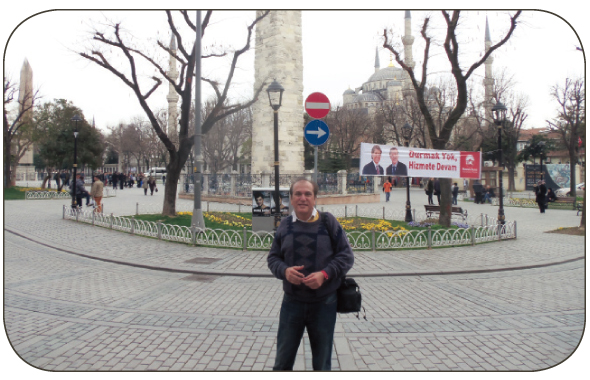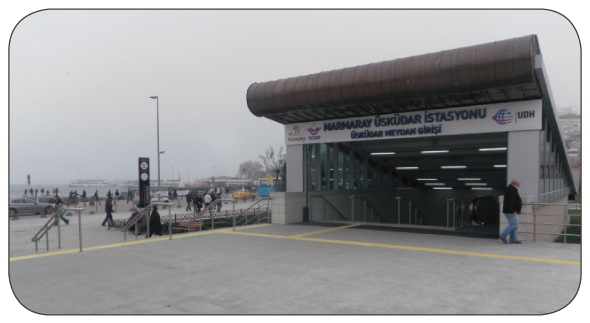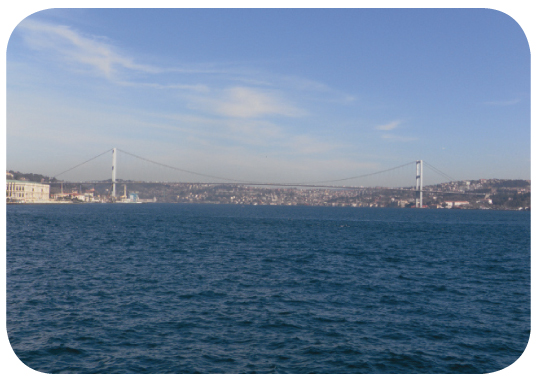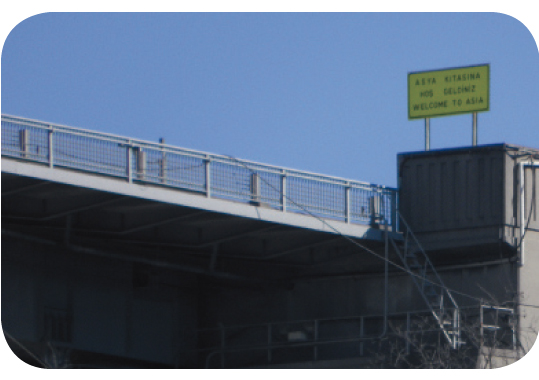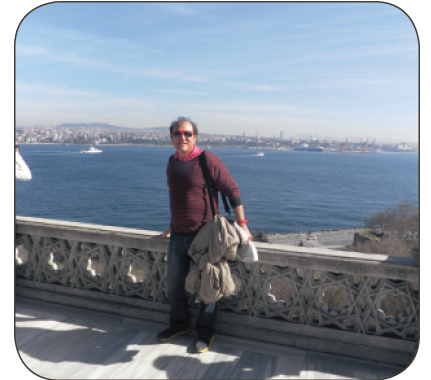Morning to Asia by Tunnel – and Back to Europe over Bridge by Evening
By Jawahar Malhotra
ISTANBUL, Turkey: The haze that had descended overnight like a thick grey veil over the mouth of the Bosphorus had brought all ship traffic to a halt, with visibility over water down to nil and over land to just 400 meters, and forced many Istanbulites to make huge changes to their commuting patterns. Thousands fled to the security of the Mamaray line – the name used for the underground subway line that crosses under the Sea of Marmara – with chaotic scenes of huge, hours long lines to get into the stations. Others, dreading the worst, made the trek over the bridges connecting the peninsulas of Europe and Asia and retold tales of their own immensely long journey back home.
“I was stuck at Takshim”, related Justine Duchanoy, a pretty, young Frenchwoman with green eyes who had just graduated from Hotel Management school in this ancient city and is now Director of Guest Relations at the Deniz Houses Hotels group, the next morning as she sat in the reception area talking of her ordeal. “I decided to go by taxi across the Bosphorus Bridge, and we barely moved 20 meters in one hour. It took three hours to get home by 10pm. I wanted to get out and walk”! And of course that would have been impossible, as all foot traffic across the bridge has been closed ever since someone jumped to their death in a suicide several years ago. Reception Desk Manager Kerem Benlicil, a long-time resident of the city with a thick moustache, nodded in commiseration, though he had not had as far to go or the water to cross.
Wednesday morning had started on an ominous note, with the fog just rolling in and barely lifting a bit by midday. Realizing that the ferry tour of the Bosphorous would be impossible to take, after the rush hour, I walked down to the Sirkeci Marmaray station in the Sultanahmet District and headed down the five escalators to the platform below, about 200 feet below the surface. The barely five month old station was starkly clean, Spartan and devoid of the type of the huge advertisements displays that you normally find in the subway systems across the world. The platform was beige tile and bare save for blue directional signs and, on the concrete, unfinished far tunnel wall, a long, 6 m (20 ft) long, painted tile mosaic showing the silhouette of the major mosques on the three peninsulas and a length of train crossing below the waters between them. The whole ride between the four stations – two on each side of the waters – was just 4 TL (or US$1.80); just as affordable as the 3 TL (US$1.30) for a ride along the entire length of the extensive tram or bus – and much smaller subway – systems.
The Mamaray – the name comes from the Sea of Marmara and “ray”, the Turkish word for rail – is the twenty-first century crowning achievement for this ancient city and came at a cost of nearly US$3 billion and nine years of construction (which began in May 2004), the last four of which were delayed due to the discovery of Byzantine era and 4,000 year-old archeological finds along the paths of the subway. It starts in the touristic and commercial area of Fatih in Europe and ends in Uskandar, Asia. The 1.4 km (0.87 mile) immersed tube tunnel is the deepest of its kind in the world; 67 m (197 ft) below sea level, with 4.6 m (15 ft) of earth and 55 m (180 ft) of water above it. The overall 13.6 km (8.5 mile) long project will eventually add more stations and upgrade the existing subway lines.
On the platform, a uniformed guard shouted commands in Turkish, and I followed the stream of commuters to the far side, behind a red ribbon cordoned off section; a few benches to one side and a slotted metal plank false ceiling above barely hiding the power cables and the lights above. The train whooshed into the platform and disgorged its passengers. Walking through the sliding doors, the carriage had the familiar look of those used in Beijing, New Delhi and Hong Kong – rows of stainless steel benches on each side, with a wide aisle for standing passengers – and above, over the doors was a graphic cross-section of the entire passage under the sea and between the two peninsulas showing the path the train used to slide underground gradually, then rise up sharply as it came to Uskandar, about seven minutes later.
Above ground, in Asia, if the weather had been clear, the Blue Mosque and the Hagia Sofia would have been visible about a mile away, but on this hazy day – a little less so at the lunch hour – all one could see was a grey fog that had drifted back about 80 m (260 ft) from land, allowing the ferry boats to ply carefully hugging the coastline. Across from the station, people loitered at the ferry plaza, catching a quick lunch of Donner Kebabs, gyros or sandwiches from the kiosks, or a donut of large Mediterranean bagels for 1 TL, or a small bag of roasted chestnuts or steamed yellow corn-on-the-cobb from the hawkers who are ubiquitous all over the city.
Almost 12 million tourists visit Istanbul every year, a city of 14.1 million – though local say unofficially 20 million – spread over 5,343 sq km (2,063 sq mi), and for a city that large it is friendly and meticulusly clean, unlike any other urban metropolis I have visited recently. Istanbulites have taken care to blend the best of the two continents to create a unique melting pot of a western looking society and lifestyle with equal emphasis on Asian hospitality and the warmth of human contact. The people are welcoming and caring, yet not aggressive or oppressive in hounding tourists for money, but leaving them to their own privacy, unlike the persistent clamor you receive from local hawkers in other developing cities, like New Delhi. Istanbul fashions range from the mostly hip “world styles” of young people all over the world and the less malleable, more conservative attire of the middle aged middle class. As a tourist, I received few curious stares; but then again it may have been because it was usually mistaken for being another Turk.
The road to the north, Pasa Lamani Cardesci, followed the coastline with small parks every so often punctuating between rows of private homes that had tall brick walls and ornate wrought iron gates enclosing the front courtyards and opened to a waterside vista. A narrow, asphalt paved sidewalk, sometimes barely there was all that stood between the walls and the roadway that was busy with public buses and vehicles; with an occasional kiosk for the attendant who sold parking time for those drivers brave enough to park alongside the house walls. On the other side of the street, on the rocky slopes, four and five story condo buildings held water views over the tops of the homes, and an occasional intersection led up the side of the hill to neighborhoods beyond. One couldn’t help but wonder how cold these decades old homes – mostly 60’s designs – would be when the frigid northerly winds blew through them.
Halfway up the 3 km long slope that led to the Bosphorus Bridge, the Pasa Lamini Café beckoned with its open gate and brown, wooden arched trellises that ran over long tables, all the way to the edge of the water and provided an excellent vantage point to view the continent crossing. The waitress brought the menu and cleared the table next to mine, tossing the leftover sliced country bread from the basket overboard into the water below, prompting a flock of seagulls – the pigeons of the seas – to descend and scoop up the pieces in their beaks, beating back competing birds with their flapping wings.
Some conservative young Muslim women walked in, attired in the modern version of the chador or burkha – bright, patterned satin headscarves tied tightly around the head, the triangular corner pointing downwards behind their head, long dark trousers and long sleeved top under dark – usually brown – overcoats with a wide belted waist and flat walking gym shoes or pumps. They asked for some tables to be joined together for what became a group of twenty women, all similarly dressed, the colors and patterns of their scarves radiating their personality – bright ones more talkative, cheerful; darker ones, quieter, somber – and all of them cheerfully and excitedly chatted away, some texted on their cellphones and ordered lunch. Across from my table, three middle aged women with short hair and in casual pants and blouses exchanged gossip, smoking cigarettes and one of them draped herself in one of the brown blankets the restaurant provided against the chill of the breeze from the water.
Further north on Pasa Lamini Caddesi, a man watched over as his grandchildren played in the small park by the water’s edge and above him loomed the western support tower of the 1,560 m (5,118 ft) long, 41 year-old Bosphorus Bridge, and halfway northward over the river, the 33.4 m (110 ft) wide main deck disappeared into a mist of fog, like a portal into the sky. I trekked along, past a military encampment on the left and a park on the right – and up to the right, at the end of the deck a sign proclaimed “Welcome to Asia”.
Up the slope that reached through the other side of the roadway tunnel under the bridge and I asked directions from a young blonde woman with dark maroon fingernail polish the way back over the bridge. “I think you can still walk across”, she said in halting, accented English, unaware of the sign posted just before the bridge that said it was a crime to do so. She was studying to become a nutritionist, and as she was going to her college in the same direction as I wanted to go, she got on the packed Metrobus with me, to guide me across the bridge to my other bus.
The doors whooshed shut and I clung to the hand strap from the bar above as the river that separated the continents flowed below us, out of sight 64 m (208 ft) below. A man with graying temples motioned at the buildings outside as we entered Europe and said something to me in Turkish, which I surmised sounded like a complaint about the distance or all the new residential tower construction that was passing by, and I instinctively mumbled in assent. He gave me a look of affirmation and we both gazed out of the windows.
At the next stop, the young woman got off and asked me to follow. “Go through that way”, she pointed to the exit turnstile, “and take the bus to Kabatas, the tram to Sirkeci is there”. I nodded as if I followed her accented, but fumbled words, “I go here, this way”, hoping I understood, as she turned. I took the way forward but there were two paths to go and a bus stop guard I enquired from motioned me to the right. After a few steps, I entered a passageway with most people rushing only in one direction but my intuition told me it was the wrong path, so I paused to ask another guard, who spoke only Turkish and ran into the young woman again, coming down. Surprised to see me, she asked, “What are you doing her? I told you straight …”, then she turned to tell the guard where I wanted to go. A young man passing by who overhead us, threw out some words in Turkish, and the woman asked him, motioning with her arm, “Go with him, he will go to the bus you need”, as she rushed to her subway.
I followed quickly after him as he took fast steps and he took me to the bus stop, where my connecting bus was just about to take off. He ran to the still open door, shouted to the driver to tell me when to get off and said to me “Bus, bus … Kabatas”, motioning me to get on. I fumbled for my three fare pass, scanned it and confirmed with the driver “Kabatas?”, motioning for him to tell me, then settled in just within eyesight of him, for the long ride down the sloping road towards the Tophane tram station on the Europe side of the dark, wide Bosphorous river.

